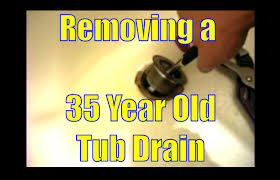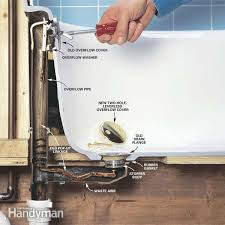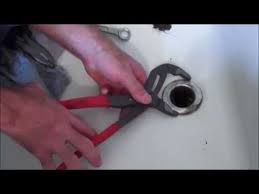How To Remove Bathtub Stopper Video

find bathtub drains and parts or view our universal tub drain stopper kits learn how to install a tub drain flange or learn how to remove a tub drain flange Your tub stopper is such a small part of your bathroom overall, yet can cause big headaches when it isn't functioning properly. If you need help figuring out how to remove or replace your tub drain stopper, you've come to the right place. ® are happy to provide you with this easy tutorial that will walk you through identifying the type of stopper you currently have and how to remove it, as well as offering tips and tricks to help ensure the process is as simple as possible. Push-Pull or Lift and Turn Trip Lever or Plunger Style Toe Touch: The stopper opens and closes with the push of your toe. Push-Pull: The stopper has a knob in the center and you must push it down to close and pull it up to open. Lift and Turn: This looks very similar to the Push-Pull style, but you will need to lift and turn the stopper (in opposite directions) to open and close.

Flip-It: This stopper uses a toggle that when flipped from side to side, will open or close. Pop-Up: This style can have a trip lever or turn style mechanism on the overflow that moves an internal push rod against a rocker arm attached to the stopper to raise or lower the stopper. Pop-Ups have a visible stopper in the tub drain, and cannot be covered by a strainer. Plunger Style: This style also use either a trip lever or turn style mechanism to operate. An internal plunger is used to stop water flow. When the overflow plate is activated by tripping a lever or turning the plate it causes the plunger to raise or lower. Trip Lever and Turn Style assemblies normally do not have a visible stopper in the tub drain. The drains simply have a strainer of some sort covering the drain. Step 1With the stopper in the "open" position (like you are emptying your tub), hold the shaft cylinder of the stopper and turn the top counter-clockwise. If this action causes the shaft cylinder to also want to turn, then release your hold on the shaft cylinder and continue to unscrew the stopper.

The shaft cylinder is threaded into the cross bar in the strainer and once it is unthreaded, lift and remove the complete stopper. Step 2However, for some Toe Touch stoppers, holding the shaft cylinder and turning the top cap will allow you to just unscrew the top finished cap portion of the stopper. If this is the case, then unscrew the top cap all the way off. Step 3Once the top cap has been unscrewed and lifted off, unscrew the shaft cylinder counter-clockwise to remove the threaded post screwed into the cross bar in the strainer. Some shaft cylinders may have a screwdriver slot to allow you to unscrew the shaft/post with the use of a screwdriver. Purchase Toe Touch Tub Stoppers Tools needed: Flathead screwdriver, clean rag, pliers Step 1The stopper can be in the "open" or "closed" position. Step 2Remove the knob on the top of the stopper. Hold the body of the stopper in place with one hand and with the other hand unscrew the knob by turning it counter-clockwise.

Note: If the knob will not unscrew, then wrap the rag around the knob and use the pliers to help remove the knob. Step 3Use a flathead screwdriver to unscrew the brass insert (post) in the middle of the stopper by turning the post counter-clockwise. The post is threaded into the crossbar of the strainer. Step 4Lift the stopper off the strainer. Tools needed: Flathead screwdriver, set of Allen wrenches
Fairy Car Seat Covers Sets Step 1With the stopper in the "open" position (like you are emptying your tub), hold the body of the stopper and slowly turn the stopper knob and look for a visible set screw on the knob.
T Shirt ResellerIf your stopper does not have a visible set screw on the knob then turn the stopper counter-clockwise until the stopper unthreads from the strainer and move on to Step 6.
Fishing Reels Reviews 2014
Step 2If your stopper does not have a visible set screw on the stopper knob and does not unscrew then you may have one of two different styles of lift and turn stoppers. One will have a set screw beneath the stopper on the post shaft. With the stopper still in the "open" position, lift the stopper up. Turn it until you see a small screw. This will be the "set" screw and you can now proceed to Step 3. If you do not see a set screw then you may have a type of stopper that has a channel built-in around the stopper. There is a pin on the strainer that the channel rotates around to accomplish the lift and turn action. Lift the stopper and begin rotating the stopper slowly counter-clockwise until the slot at the bottom of the channel aligns with the pin on the strainer releasing the stopper to pull upwards. Step 3Either a screwdriver or allen wrench is needed to loosen the set screw. Typically, you do not need to remove the screw entirely, simply loosen it enough to remove the stopper.

Step 4Lift the stopper off the post. If your stopper has a set screw and will not pull off the post then try loosening the set screw a little more. If the set screw is removed and it will still not slide off the post, then there may be a calcium water build-up between the stopper and the post. You may wish to use a liquid wrench type solvent or exert more pressure since the stopper should lift off the post. Step 5Once the stopper is lifted off of the post then unscrew the post from the strainer. Step 6Lift off the stopper. If your stopper does not have a set screw and it does not lift off, but continues "spinning" without unscrewing, then the post threads could be stripped and you would need to exert upward pressure while unscrewing the stopper in hopes of unthreading it from the strainer. If this maneuver does not work then you will need to unscrew the bath waste flange from the drain pipe. Quick Tip: We recommend replacing Lift & Turn Stoppers with Push-Pull Stoppers as they are much easier to operate.

All you have to do is pull up on the stopper to open it, but with lift & turn stoppers it can often be a hassle to find the right spot where the stopper will stay up or go back down. This is probably the easiest stopper to remove as all you'll need to do is pull it free from your drain! Step 1O-rings keep this Flip-It tub drain stopper in place. Gently grasp the outer chrome round body (not the toggle) and begin to rotate the stopper pulling upwards at the same time. It does not matter in which direction you rotate the stopper. Sometimes wiggling back and forth while pulling up may work as well. Purchase the Flip-It Drain Stopper Tools needed: Bucket, clean rag Pop-up tub drains have a stopper that is controlled by a mechanism on the overflow faceplate. Some overflow face plates have a trip lever that moves up and down. Some faceplates have a lever that rotates left or right. Many have entire faceplates that rotate like on some cable operated bath wastes. Step 1Flip the trip lever, or rotate the overflow faceplate, so that the stopper is in the open position.

Step 2Some pop-up stoppers pull straight up without much effort, and some must be wiggled back and forth when pulling up. Some stoppers have a "rocker arm" attached to the stopper requiring the stopper to be pulled up just enough to clear the drain and then immediately pulled horizontally away from the drain. If you have this type of stopper you will know it when you start to pull it up and see the attached arm underneath. You will want to put a clean rag on the bottom of the tub beginning at the drain to cover the tub and keep the rocker arm from scratching your tub. This can often be messy as this portion of the drain usually has an accumulation of hair, soap and other debris. It's recommended you have a bucket handy to place these parts into. This helps to prevent any lost parts, damage to your tub and to keep your work area tidy. Purchase Brass Bodied Cable Operated Tub Drain Pop-Up Assemblies Purchase Plastic Bodied Cable Operated Tub Drain Pop-Up Assemblies Plunger tub drains have a stopper located inside the waste and overflow pipe, and are activated using a Trip Lever or Turn Style overflow plate.

Most will have a strainer plate covering the drain. This cover plate simply screws into the body of the drain, as shown in this example, and can be removed or changed by just unscrewing it. Step 1Locate the screws on the trip lever. Step 2You will need to remove the screws from the cover plate of the trip lever, however, remove only one screw from the faceplate at first. With a screwdriver begin to slowly loosen and remove one of the screws, either one, your choice. Step 3Once one of the screws is removed then hold the faceplate securely and begin to slowly remove the other screw. As the faceplate is loosened it will begin to swivel. As soon as the faceplate is loose enough to swing down and away (be careful not to scratch your tub) to reveal the opposite side screw hole, reinstall the first screw back into the now exposed overflow elbow just a few turns. This maneuver can help you in two ways. If your overflow elbow is loose it can keep the loose elbow and piping from disappearing behind the tub.